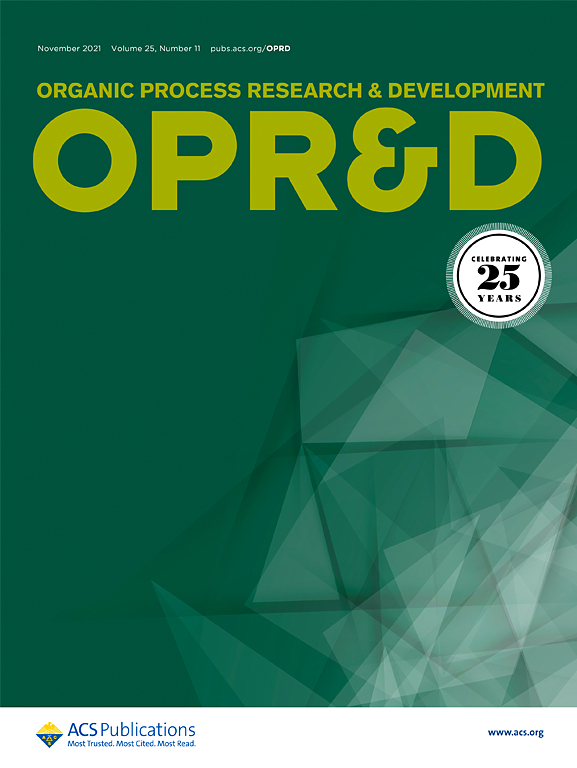Efficient and Scalable Diastereoselective Synthesis of ((2R,7aS)-2-fluorotetrahydro-1H-pyrrolizin-7a(5H)-yl)methanol Hydrochloride
IF 3.1
3区 化学
Q2 CHEMISTRY, APPLIED
引用次数: 0
Abstract
An efficient large-scale synthesis of 2a·HCl, a key fragment to several KRAS inhibitors, is described. Optimization to a previously reported racemic route by Merck includes the development of a catalytic exocyclic olefin oxidation using RuCl3/NaIO4, followed by a highly diastereoselective reduction of the resulting ketone. A second-generation approach was then developed. The highlight of this synthesis includes a one-step intramolecular nucleophilic ring cyclization of 35a or 35b via a stable chelate with lithium cation 38 to give a stereoselective product, bicyclic scaffold 36a, with excellent diastereoselectivity and good yields. Consecutive deoxyfluorination followed by the reduction of benzyl ester 37a afforded 2a·HCl without the need for chiral separation utilized in the first-generation approach.

高效可扩展非对映选择性合成((2R,7aS)-2-氟四氢- 1h -吡咯利嗪-7a(5H)-基)甲醇盐酸盐
描述了一种高效的大规模合成2a·HCl,这是几种KRAS抑制剂的关键片段。默克公司对先前报道的外消旋途径进行了优化,包括使用RuCl3/NaIO4开发催化外环烯烃氧化,然后对生成的酮进行高度非对映选择性还原。第二代方法随后被开发出来。该合成的亮点包括通过与锂离子38的稳定螯合物一步将35a或35b亲核环环化,得到立体选择性产物双环支架36a,具有优异的非对映选择性和良好的产率。连续脱氧氟化,然后还原苯甲酯37a,得到2a·HCl,而不需要采用第一代方法进行手性分离。
本文章由计算机程序翻译,如有差异,请以英文原文为准。
求助全文
约1分钟内获得全文
求助全文
来源期刊
CiteScore
6.90
自引率
14.70%
发文量
251
审稿时长
2 months
期刊介绍:
The journal Organic Process Research & Development serves as a communication tool between industrial chemists and chemists working in universities and research institutes. As such, it reports original work from the broad field of industrial process chemistry but also presents academic results that are relevant, or potentially relevant, to industrial applications. Process chemistry is the science that enables the safe, environmentally benign and ultimately economical manufacturing of organic compounds that are required in larger amounts to help address the needs of society. Consequently, the Journal encompasses every aspect of organic chemistry, including all aspects of catalysis, synthetic methodology development and synthetic strategy exploration, but also includes aspects from analytical and solid-state chemistry and chemical engineering, such as work-up tools,process safety, or flow-chemistry. The goal of development and optimization of chemical reactions and processes is their transfer to a larger scale; original work describing such studies and the actual implementation on scale is highly relevant to the journal. However, studies on new developments from either industry, research institutes or academia that have not yet been demonstrated on scale, but where an industrial utility can be expected and where the study has addressed important prerequisites for a scale-up and has given confidence into the reliability and practicality of the chemistry, also serve the mission of OPR&D as a communication tool between the different contributors to the field.

 求助内容:
求助内容: 应助结果提醒方式:
应助结果提醒方式:


